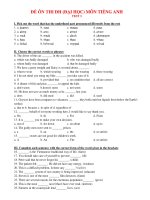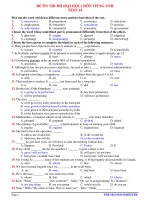Tài liệu ĐỀ ÔN THI ĐH (ĐẠI HỌC) MÔN TIẾNG ANH TEST 4 ppt
Bạn đang xem bản rút gọn của tài liệu. Xem và tải ngay bản đầy đủ của tài liệu tại đây (92.15 KB, 8 trang )
ĐỀ ÔN THI ĐH (ĐẠI HỌC) MÔN TIẾNG ANH
TEST 4
I. Pick out the wordthat hasthe underlinedpart pronouncedifferently
from the rest
1. a. surface b. face c. facial d. facing
2. a. device b. advice c. practice d. mice
3. a. liberation b. library c. limit d. lip
4. a. choose b. lose c. whose d. loose
5. a. protects b. kicks c. misses d. stops
II. Choosethe correct words or phrases
6. Technology plays a key role in _______ future.
a. to shape b. shaping c. shaped d. shape
7. Some snakes lay eggs, but _______ give birth to live offspring.
a. other b. the other c. others d. the others
8. These trousers need _______.
a. clean b. to clean c. cleaning d. cleaned
9. Let's wait until the rain _______.
a. stops b. will stop c. has stopped d. is stopping
10. I am right, _______?
a. am not I b. don't I c. aren't I d. am I
11. We could not avoid _______ what they were talking about you.
a. overhear b. to overhear c. overheard d. overhearing
12. My father sometimes _______ the washing up after dinner.
a. washes b. takes c. makes d. does
13. I don't like hunting. - _______.
a. Either do I b. I do, too c. Neither do I d. I don't neither
14. Your car is _______ more expensive than mine.
a. many b. much c. far d. b and c
15. She is Vietnamese _______ birth but she was born in the US.
a. by b. on c. from d. up
III. Complete each sentence with the correct form of the word given in
the brackets
16. He could not hide his _______ for the interview. (anxious)
17. Every _______ has made good preparations. (participate)
18. Most of our furniture is in _______. (store)
19. She gave birth to a _______ child. (health)
20. Cheque cards have a _______ number. (specialize)
21. I have ever dreamt of becoming a _______. (chemistry)
22. It is a/an _______ memory. I'll remember it eternally. (forget)
23. This tin opener is _______. Throw it away. (use)
24. Barter system was _______ so people needed a monetary system.
(satisfy)
25. That company is in _______ difficulty. (finance)
IV. Fill in each numbered blank with ONE suitable word
One step beyond automated machines is the (26) _______ robot, the heart
and brain (27) _______ which is the microcomputer. Unlike most automated
machines, industrial robots can (28) _______ programmed to do a variety of
tasks (29) _______ are usually accomplished by human factory workers.
Like their human (30) _______, industrial robots can be switched from one
job to (31) _______ and can be programmed to (32) _______ new tasks.
Thus, robots have found their greatest use in assembling (33) _______
components. However, they are swiftly branching (34) _______ basic
assembly operations to construction and mining, and their (35) _______
wonderful use of all is the exploration of oceans and outer space.
26. a. industry b. industrial c. industrialize d. industrialization
27. a. of b. in c. from d. for
28. a. to be b. be c. is d. being
29. a. who b. whom c. whose d. that
30. a. combination b. counterpart c. evaluation d. abolishment
31. a. some b. any c. another d. others
32. a. handle b. expose c. judge d. compare
33. a. mechanic b. mechanical c. mechanics d. mechanization
34. a. for b. onto c. from d. forward
35. a. most b. best c. worse d. less
V. Read the passage carefully and then answer the questions
It is the environment in which we breathe that must have changed, and there
is plenty of evidence that tells us it has. Plus, we also know that it is airborne
pollutants and elements that usually cause asthma attacks and other
respiratory problems. Most people believe it is the air outdoors that presents
us with the greatest risk. However, it is actually the air inside our houses,
schools, and other buildings that is most harmful. According to the
Ainerican College of Allergies, 50% of all illnesses is aggravated or caused
by polluted indoor air.
Today's homes and buildings are built airtight, with energy-efficiency inside.
Their airtight construction keep airborne pollutants trapped inside, nature's
air cleansing agents outside. Is it any wonder that statistics for asthma
problems began rising sharply around the same time that homes and
buildings began to be built this way? In fact, a recent study found that the
allergen level in super-insulated homes is 200% higher than it is in ordinary
homes. Plus, according to Scientific America, a baby crawling on the floor
inhales the equivalent of 4 cigarettes a day, as a result of the outgas of
carpets, molds, mildews, fungi, dust mites, etc. Most people spend a lot of
their time inside. In which case, indoor air is going to impact our health far
more than outdoor air. Virtually, everyone is affected, especially asthmatics
and others who are particularly sensitive to allergens and contaminants in the
air. It is informed that 6 out of 10 houses and buildings are "sick", meaning
they are hazardous to your health to occupy, as a result of airborne
pollutants. In fact, every house and building is affected by the indoor air
quality epidemic to one degree or another, regardless of how clean it may
appear. Every home is filled with prime sources that contribute to mass
quantities of airborne allergens and contaminants.
For instance, if your home looks really clean, you should ask yourself how it
became that way. Did you use aerosols, floor and furniture polish, bleach,
bathroom cleaners, etc.? If so, these products emit harmful chemical vapors
into the air.









